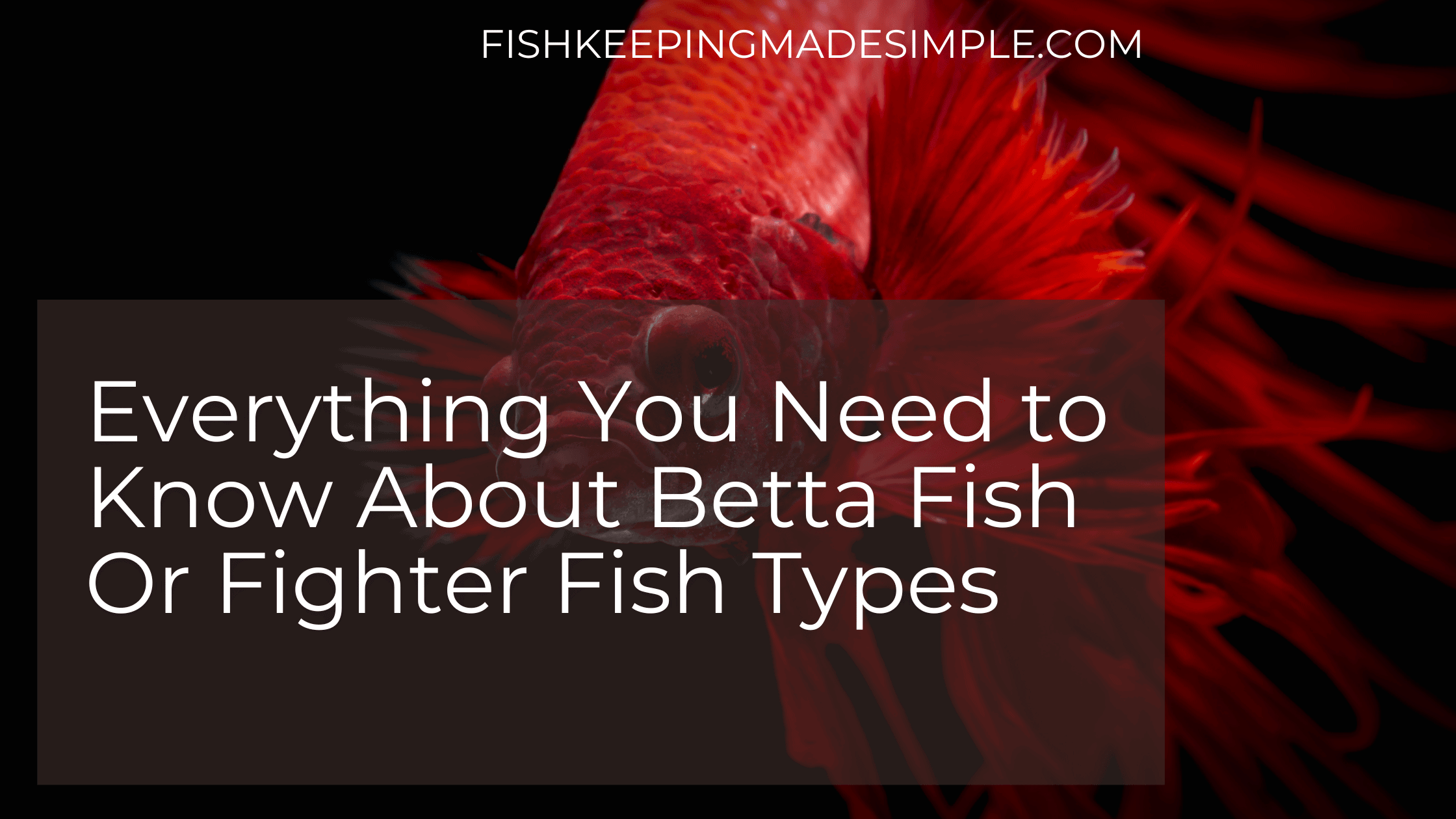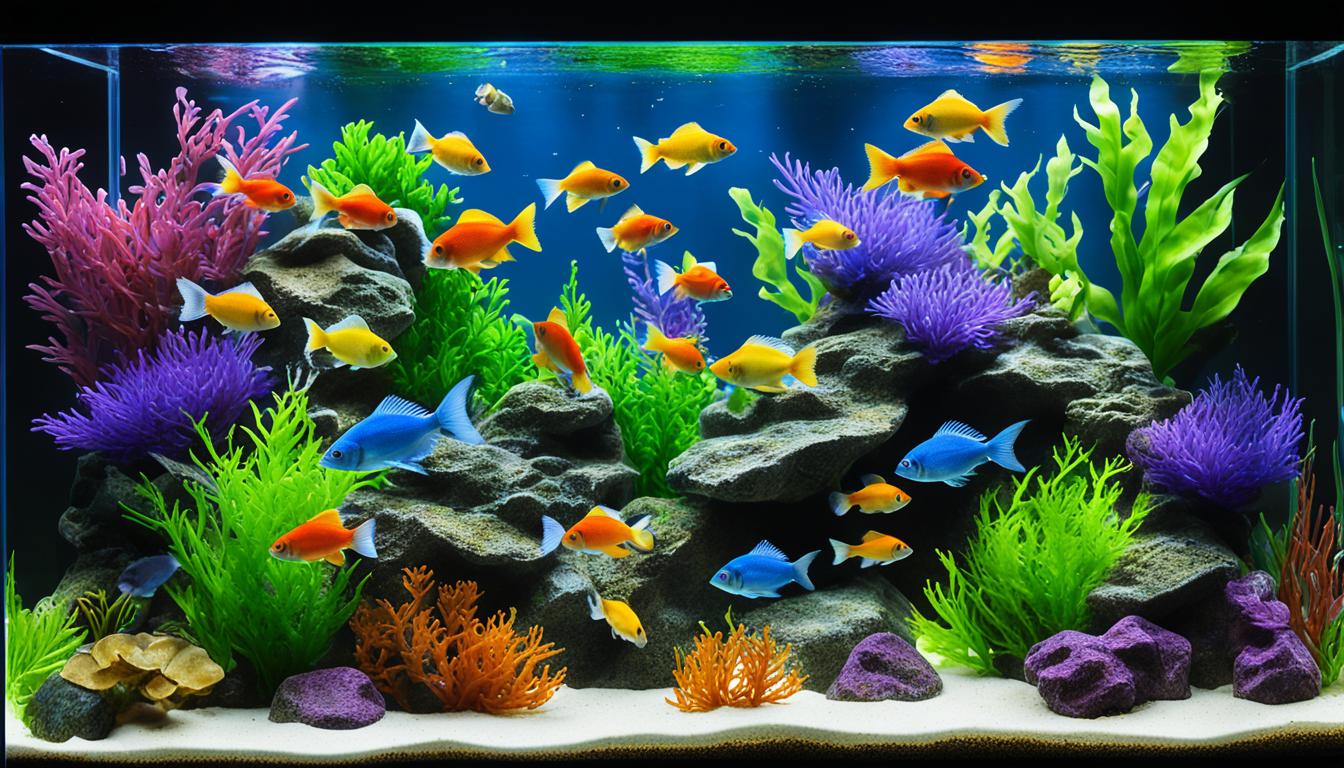Betta fish, also known as Siamese fighting fish, are a popular species of freshwater fish due to their vibrant colors and unique personalities. However, not all betta fish are created equal. There are different types of betta fish, each with its own unique characteristics, habitat, food habits, and care requirements. In this article, we will provide a comprehensive guide to the different types of betta fish and help you choose the right one for you.
Table of Contents
Popular Betta Fish Types & Their Characteristics
There are several types of betta fish, each with its own unique characteristics. Some of the most popular types include: Veil Tail Betta, Halfmoon Betta, Crown Tail Betta, Delta Tail Betta, Plakat Betta, Double Tail Betta and Wild Betta.
Please find the list of most of the popular Betta fish in the Aquarium hobby.
Veil Tail Betta
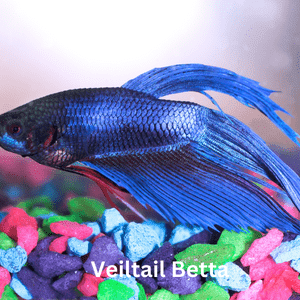
Veil Tail Betta, also known as VT Betta, is one of the most common types of betta fish and is characterized by its long, flowing fins and tail. The fins of a veil tail betta can grow up to twice the length of its body and they are known for their vibrant colors and peaceful personalities. They are native to Southeast Asia, particularly Thailand, and are considered as the standard form of betta fish.
Veil Tail Bettas prefer a tank with a lot of plants and hiding spots, and a water temperature of 76-80°F with pH levels between 6.5-7.5. They are relatively easy to breed and can adapt well to different water conditions.
In terms of tank size, Veil Tail Bettas require at least 2.5 gallons of water and this tank should be equipped with a good filter and heater to maintain the temperature and water quality. They are relatively hardy fish, but they are sensitive to poor water conditions and require regular water changes and a high-quality water conditioner.
In terms of diet, Veil Tail Bettas are carnivorous and prefer a diet of live or frozen food such as brine shrimp, bloodworms, and daphnia.
Overall, Veil Tail Bettas are a great option for those who are new to keeping betta fish and are looking for a colorful and peaceful fish that is easy to care for. With proper care, a Veil Tail Betta can live for up to 3-4 years.
Halfmoon Betta
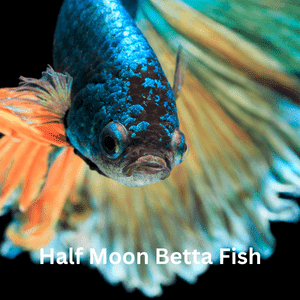
Halfmoon Betta, also known as HM Betta, is a type of betta fish that is known for its large and symmetrical tail fins that can spread out to a 180-degree angle. These fins are what gives the Halfmoon Betta its unique and striking appearance, making it one of the most sought-after bettas among aquarium enthusiasts.
Halfmoon Bettas are native to Southeast Asia, specifically Thailand, and they prefer a cooler water temperature of 76-78°F and a pH level of 6.5-7.0. They require a tank with a moderate current and plenty of hiding spots to feel comfortable. They are relatively hardy fish, but they are sensitive to poor water conditions and require regular water changes and a high-quality water conditioner.
In terms of tank size, Halfmoon Bettas require at least 2.5 gallons of water, and the tank should be equipped with a good filter and heater to maintain the temperature and water quality.
In terms of diet, Halfmoon Bettas are carnivorous and prefer a diet of live or frozen food such as brine shrimp, bloodworms, and daphnia.
When it comes to breeding, Halfmoon Bettas are considered more difficult to breed than other types of bettas. They require specific water conditions and a proper diet to breed successfully.
Overall, Halfmoon Bettas are a great option for experienced betta fish keepers who are looking for a colorful and unique fish that requires a bit more attention and care. With proper care, a Halfmoon Betta can live for up to 3-4 years.
Crown Tail Betta
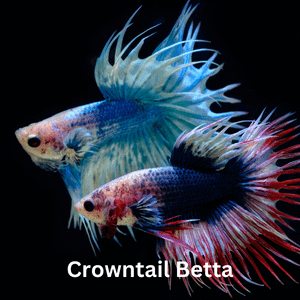
Crown Tail Betta, also known as CT Betta, is a type of betta fish that is characterized by its elongated and frayed fins, giving it the appearance of a “crown” on its tail. This unique fin structure is the result of selective breeding and is what makes the Crown Tail Betta stand out among other types of bettas.
Crown Tail Bettas are native to Southeast Asia, specifically Thailand, and they prefer a moderate current and plenty of hiding spots in their tank, and a water temperature of 76-80°F with pH levels between 6.5-7.5. They are relatively easy to breed and can adapt well to different water conditions.
In terms of tank size, Crown Tail Bettas require at least 2.5 gallons of water and this tank should be equipped with a good filter and heater to maintain the temperature and water quality. They are relatively hardy fish, but they are sensitive to poor water conditions and require regular water changes and a high-quality water conditioner.
In terms of diet, Crown Tail Bettas are carnivorous and prefer a diet of live or frozen food such as brine shrimp, bloodworms, and daphnia.
Overall, Crown Tail Bettas are a great option for those who are looking for a unique and striking fish that is easy to care for. They are hardy and adaptable making them suitable for both experienced and novice betta fish keepers. With proper care, a Crown Tail Betta can live for up to 3-4 years.
Delta Tail Betta

Delta Tail Betta, also known as DT Betta, is a type of betta fish that is characterized by its broad and triangular tail fins. Delta Tail Bettas are known for their hardiness and easy-going personalities. They are native to Southeast Asia, specifically Thailand and adapt well to different water conditions.
Delta Tail Bettas prefer a moderate current and plenty of hiding spots in their tank, and a water temperature of 76-80°F with pH levels between 6.5-7.5. They are relatively easy to breed and can adapt well to different water conditions.
In terms of tank size, Delta Tail Bettas require at least 2.5 gallons of water and this tank should be equipped with a good filter and heater to maintain the temperature and water quality. They are relatively hardy fish, but they are sensitive to poor water conditions and require regular water changes and a high-quality water conditioner.
In terms of diet, Delta Tail Bettas are carnivorous and prefer a diet of live or frozen food such as brine shrimp, bloodworms, and daphnia.
Overall, Delta Tail Bettas are a great option for those who are looking for a hardy and easy-going fish that is easy to care for. They are adaptable and suitable for both experienced and novice betta fish keepers. With proper care, a Delta Tail Betta can live for up to 3-4 years.
Plakat Betta

Plakat Betta, also known as PK Betta, is a type of betta fish that is characterized by its short fins and stocky body. Plakat Bettas are known for their active and aggressive personalities. They are native to Southeast Asia, specifically Thailand, and require a larger tank with plenty of room to swim.
Plakat Bettas prefer slightly warmer water and a pH level of 7.0-7.5, they are adaptable to different water conditions. They are relatively easy to breed.
In terms of tank size, Plakat Bettas require at least 2.5 gallons of water and this tank should be equipped with a good filter and heater to maintain the temperature and water quality. They are relatively hardy fish, but they are sensitive to poor water conditions and require regular water changes and a high-quality water conditioner.
In terms of diet, Plakat Bettas are carnivorous and prefer a diet of live or frozen food such as brine shrimp, bloodworms, and daphnia.
Overall, Plakat Bettas are a great option for those who are looking for an active and aggressive fish that requires a bit more space to swim. They are adaptable and suitable for both experienced and novice betta fish keepers. With proper care, a Plakat Betta can live for up to 3-4 years.
Double Tail Betta
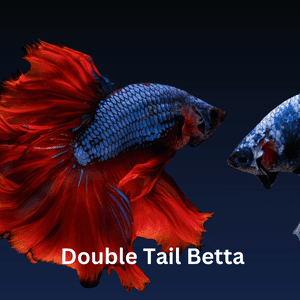
Double Tail Betta, also known as DT Betta, is a type of betta fish that is characterized by its double tail, which is a genetic mutation. Double Tail Bettas are known for their unique and striking appearance, They are native to Southeast Asia, specifically Thailand, and require a larger tank with plenty of room to swim.
Double Tail Bettas are adaptable to different water conditions and prefer a water temperature range between 76-80°F with pH levels between 6.5-7.5. They are relatively easy to breed.
In terms of tank size, Double Tail Bettas require at least 2.5 gallons of water and this tank should be equipped with a good filter and heater to maintain the temperature and water quality. They are relatively hardy fish, but they are sensitive to poor water conditions and require regular water changes and a high-quality water conditioner.
In terms of diet, Double Tail Bettas are carnivorous and prefer a diet of live or frozen food such as brine shrimp, bloodworms, and daphnia.
Overall, Double Tail Bettas are a great option for those who are looking for a unique and striking fish that requires a bit more space to swim. They are adaptable and suitable for both experienced and novice betta fish keepers. With proper care, a Double Tail Betta can live for up to 3-4 years.
Koi Betta

Koi Betta is a type of betta fish that is characterized by its unique color patterns and patterns similar to those of Koi fish. They are also called Butterfly Bettas, due to their unique and vibrant colors that resemble those of a butterfly. They are not a naturally occurring variant of betta fish but they are selectively bred and it’s a result of crossbreeding different color variants of betta fish.
Koi Bettas require a moderate current and plenty of hiding spots in their tank, and a water temperature of 76-80°F with pH levels between 6.5-7.5. They are relatively hardy fish, but they are sensitive to poor water conditions and require regular water changes and a high-quality water conditioner.
In terms of tank size, Koi Bettas require at least 2.5 gallons of water and this tank should be equipped with a good filter and heater to maintain the temperature and water quality.
In terms of diet, Koi Bettas are carnivorous and prefer a diet of live or frozen food such as brine shrimp, bloodworms, and daphnia.
Overall, Koi Bettas are a great option for those who are looking for a unique and striking fish that is easy to care for, they are hardy and adaptable making them suitable for both experienced and novice betta fish keepers. With proper care, a Koi Betta can live for up to 3-4 years.
Hellboy Betta
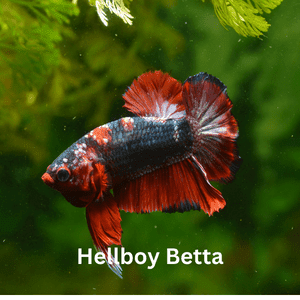
Hellboy Betta is a type of betta fish that is characterized by its unique red and black color patterns. The name “Hellboy” comes from the fish’s dark red and black coloration, which resembles the comic book and movie character of the same name. They are not a naturally occurring variant of betta fish but they are selectively bred, it’s a result of crossbreeding different color variants of betta fish.
Hellboy Bettas require a moderate current and plenty of hiding spots in their tank, and a water temperature of 76-80°F with pH levels between 6.5-7.5. They are relatively hardy fish, but they are sensitive to poor water conditions and require regular water changes and a high-quality water conditioner.
In terms of tank size, Hellboy Bettas require at least 2.5 gallons of water and this tank should be equipped with a good filter and heater to maintain the temperature and water quality.
In terms of diet, Hellboy Bettas are carnivorous and prefer a diet of live or frozen food such as brine shrimp, bloodworms, and daphnia.
Overall, Hellboy Bettas are a great option for those who are looking for a unique and striking fish that is easy to care for, they are hardy and adaptable making them suitable for both experienced and novice betta fish keepers. With proper care, a Hellboy Betta can live for up to 3-4 years.
Wild Betta

Wild Betta, also known as Betta Splendens, are the ancestors of the domesticated betta fish that are commonly kept in aquariums. They are native to Southeast Asia, specifically Thailand, Cambodia, and Vietnam and are known for their vibrant colors and aggressive personalities. Wild bettas are typically smaller and less colorful than their domesticated counterparts.
Wild Bettas prefer a natural habitat with plenty of plants, hiding spots, and a moderate current, and a water temperature range between 78-82°F with pH levels between 6.5-7.5. They are relatively hardy fish but are sensitive to poor water conditions and require regular water changes and a high-quality water conditioner.
In terms of tank size, Wild Bettas require at least 2.5 gallons of water and this tank should be equipped with a good filter and heater to maintain the temperature and water quality, and providing a suitable tank setup that mimics their natural habitat is important.
In terms of diet, Wild Bettas are carnivorous and prefer a diet of live or frozen food such as brine shrimp, bloodworms, and daphnia.
Overall, Wild Bettas are a great option for those who are looking for a unique and striking fish that is easy to care for, they are hardy and adaptable making them suitable for both experienced and novice betta fish keepers. With proper care, a Wild Betta can live for up to 3-4 years.
Blue Betta Fish
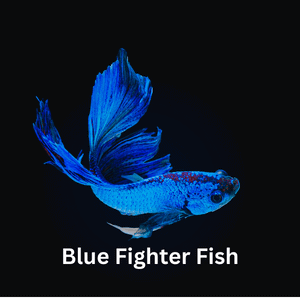
Blue Betta Fish, also known as Blue Fighter Fish, is a type of betta fish that is characterized by its striking blue coloration. Blue Bettas are not a naturally occurring variant of betta fish but they are selectively bred and it’s a result of crossbreeding different color variants of betta fish.
Blue Bettas require a moderate current and plenty of hiding spots in their tank, and a water temperature of 76-80°F with pH levels between 6.5-7.5. They are relatively hardy fish, but they are sensitive to poor water conditions and require regular water changes and a high-quality water conditioner.
In terms of tank size, Blue Bettas require at least 2.5 gallons of water and this tank should be equipped with a good filter and heater to maintain the temperature and water quality.
In terms of diet, Blue Bettas are carnivorous and prefer a diet of live or frozen food such as brine shrimp, bloodworms, and daphnia.
Overall, Blue Bettas are a great option for those who are looking for a unique and striking fish that is easy to care for, they are hardy and adaptable making them suitable for both experienced and novice betta fish keepers. With proper care, a Blue Betta can live for up to 3-4 years.
Full Moon Betta

Full Moon Betta, also known as Halfmoon Plakat Betta, is a type of betta fish that is characterized by its large and round tail fins that can spread out to a 180-degree angle. These fins are what gives the Full Moon Betta its unique and striking appearance, making it one of the most sought-after bettas among aquarium enthusiasts. This type of betta is a result of crossbreeding between Halfmoon Betta and Plakat Betta
Full Moon Bettas are adaptable to different water conditions and prefer a water temperature range between 76-80°F with pH levels between 6.5-7.5. They are relatively hardy fish, but they are sensitive to poor water conditions and require regular water changes and a high-quality water conditioner.
In terms of tank size, Full Moon Bettas require at least 2.5 gallons of water and this tank should be equipped with a good filter and heater to maintain the temperature and water quality. They also require plenty of hiding spots and room to swim.
In terms of diet, Full Moon Bettas are carnivorous and prefer a diet of live or frozen food such as brine shrimp, bloodworms, and daphnia.
Overall, Full Moon Bettas are a great option for those who are looking for a unique and striking fish that is easy to care for, they are hardy and adaptable making them suitable for both experienced and novice betta fish keepers. With proper care, a Full Moon Betta can live for up to 3-4 years.
White Betta
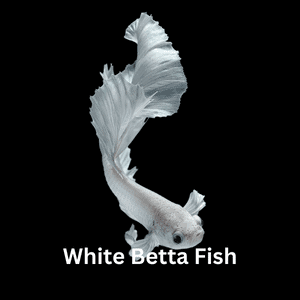
White Betta Fish is a type of betta fish that is characterized by its pure white coloration. White Bettas are not a naturally occurring variant of betta fish but they are selectively bred and it’s a result of crossbreeding different color variants of betta fish. They are considered to be a rare and highly prized fish among betta enthusiasts.
White Bettas require a moderate current and plenty of hiding spots in their tank, and a water temperature of 76-80°F with pH levels between 6.5-7.5. They are relatively hardy fish, but they are sensitive to poor water conditions and require regular water changes and a high-quality water conditioner.
In terms of tank size, White Bettas require at least 2.5 gallons of water and this tank should be equipped with a good filter and heater to maintain the temperature and water quality.
In terms of diet, White Bettas are carnivorous and prefer a diet of live or frozen food such as brine shrimp, bloodworms, and daphnia.
Overall, White Bettas are a great option for those who are looking for a unique and striking fish that is easy to care for, they are hardy and adaptable making them suitable for both experienced and novice betta fish keepers. With proper care, a White Betta can live for up to 3-4 years. Note that, Bettas with pure white coloration are hard to come by and are considered to be more expensive than other types of bettas.
Mustard Gas Betta

Mustard Gas Betta, also known as MG Betta, is a type of betta fish that is characterized by its unique color pattern of metallic blue and yellow. The name “Mustard Gas” comes from the fish’s yellow and blue coloration, which resembles the chemical weapon of the same name. They are not a naturally occurring variant of betta fish but they are selectively bred and it’s a result of crossbreeding different color variants of betta fish.
Mustard Gas Bettas are adaptable to different water conditions and prefer a water temperature range between 76-80°F with pH levels between 6.5-7.5. They are relatively hardy fish, but they are sensitive to poor water conditions and require regular water changes and a high-quality water conditioner.
In terms of tank size, Mustard Gas Bettas require at least 2.5 gallons of water and this tank should be equipped with a good filter and heater to maintain the temperature and water quality. They also require plenty of hiding spots and room to swim.
In terms of diet, Mustard Gas Bettas are carnivorous and prefer a diet of live or frozen food such as brine shrimp, bloodworms, and daphnia.
Overall, Mustard Gas Bettas are a great option for those who are looking for a unique and striking fish that is easy to care for, they are hardy and adaptable making them suitable for both experienced and novice betta fish keepers. With proper care, a Mustard Gas Betta can live for up to 3-4 years. These types of Bettas are highly prized among betta enthusiasts for their unique and vibrant coloration. It’s important to keep in mind that the coloration of Mustard Gas Bettas may change with age and can be affected by the quality of water, lighting, and diet.
Red Galaxy Koi betta

Red Galaxy Koi Betta is a type of betta fish that is characterized by its unique red and white color pattern that resembles a galaxy. The name “Red Galaxy Koi” comes from the fish’s red and white coloration, which resembles the colors of a koi fish and the galaxy. They are not a naturally occurring variant of betta fish but they are selectively bred and it’s a result of crossbreeding different color variants of betta fish.
Red Galaxy Koi Bettas are adaptable to different water conditions and prefer a water temperature range between 76-80°F with pH levels between 6.5-7.5. They are relatively hardy fish, but they are sensitive to poor water conditions and require regular water changes and a high-quality water conditioner.
In terms of tank size, Red Galaxy Koi Bettas require at least 2.5 gallons of water and this tank should be equipped with a good filter and heater to maintain the temperature and water quality. They also require plenty of hiding spots and room to swim.
In terms of diet, Red Galaxy Koi Bettas are carnivorous and prefer a diet of live or frozen food such as brine shrimp, bloodworms, and daphnia.
Overall, Red Galaxy Koi Bettas are a great option for those who are looking for a unique and striking fish that is easy to care for, they are hardy and adaptable making them suitable for both experienced and novice betta fish keepers. With proper care, a Red Galaxy Koi Betta can live for up to 3-4 years. These types of Bettas are highly prized among betta enthusiasts for their unique and vibrant coloration. The red and white coloration of the Red Galaxy Koi Betta creates a striking contrast and is sure to catch the eye of anyone who sees it. These fish are relatively hardy and easy to care for, making them a great option for both experienced and novice betta fish keepers. They are also considered to be rare and more expensive than other types of Bettas.
Black Samurai Betta

Black Samurai Betta is a type of betta fish that is characterized by its deep black coloration. The name “Black Samurai” comes from the fish’s dark coloration, which resembles the armor of a Samurai warrior. They are not a naturally occurring variant of betta fish but they are selectively bred and it’s a result of crossbreeding different color variants of betta fish.
Black Samurai Bettas are adaptable to different water conditions and prefer a water temperature range between 76-80°F with pH levels between 6.5-7.5. They are relatively hardy fish, but they are sensitive to poor water conditions and require regular water changes and a high-quality water conditioner.
In terms of tank size, Black Samurai Bettas require at least 2.5 gallons of water and this tank should be equipped with a good filter and heater to maintain the temperature and water quality. They also require plenty of hiding spots and room to swim.
In terms of diet, Black Samurai Bettas are carnivorous and prefer a diet of live or frozen food such as brine shrimp, bloodworms, and daphnia.
Overall, Black Samurai Bettas are a great option for those who are looking for a unique and striking fish that is easy to care for, they are hardy and adaptable making them suitable for both experienced and novice betta fish keepers. With proper care, a Black Samurai Betta can live for up to 3-4 years. These types of Bettas are highly prized among betta enthusiasts for their deep black coloration, which creates a striking contrast and is sure to catch the eye of anyone who sees it.
Dragon Scale Betta

Dragon Scale Betta, also known as Dragon Betta or Dragon Scale Halfmoon, is a type of betta fish that is characterized by its unique scale pattern that resembles the scales of a dragon. They are not a naturally occurring variant of betta fish but they are selectively bred, it’s a result of crossbreeding different color variants of betta fish.
Dragon Scale Bettas require a moderate current and plenty of hiding spots in their tank, and a water temperature of 76-80°F with pH levels between 6.5-7.5. They are relatively hardy fish, but they are sensitive to poor water conditions and require regular water changes and a high-quality water conditioner.
In terms of tank size, Dragon Scale Bettas require at least 2.5 gallons of water and this tank should be equipped with a good filter and heater to maintain the temperature and water quality.
In terms of diet, Dragon Scale Bettas are carnivorous and prefer a diet of live or frozen food such as brine shrimp, bloodworms, and daphnia.
Overall, Dragon Scale Bettas are a great option for those who are looking for a unique and striking fish that is easy to care for, they are hardy and adaptable making them suitable for both experienced and novice betta fish keepers. With proper care, a Dragon Scale Betta can live for up to 3-4 years. They are highly prized among betta enthusiasts for their unique scale pattern, which resembles the scales of a dragon and creates a striking contrast and is sure to catch the eye of anyone who sees it.
How to Tell the Difference Between Male And Female Betta Fish
One of the most common questions when it comes to betta fish is how to tell the difference between male and female bettas. Male bettas are known for their vibrant colors, longer fins, and more aggressive personalities. Female bettas, on the other hand, tend to be less colorful, have shorter fins, and are less aggressive.
However, the best way to tell the difference between a male and female betta is to look at their reproductive organs. Male bettas have a modified anal fin called a gonopodium, which is used for fertilizing eggs. Female bettas, on the other hand, have a rounder belly and a small white dot on their belly, which is their ovipositor.
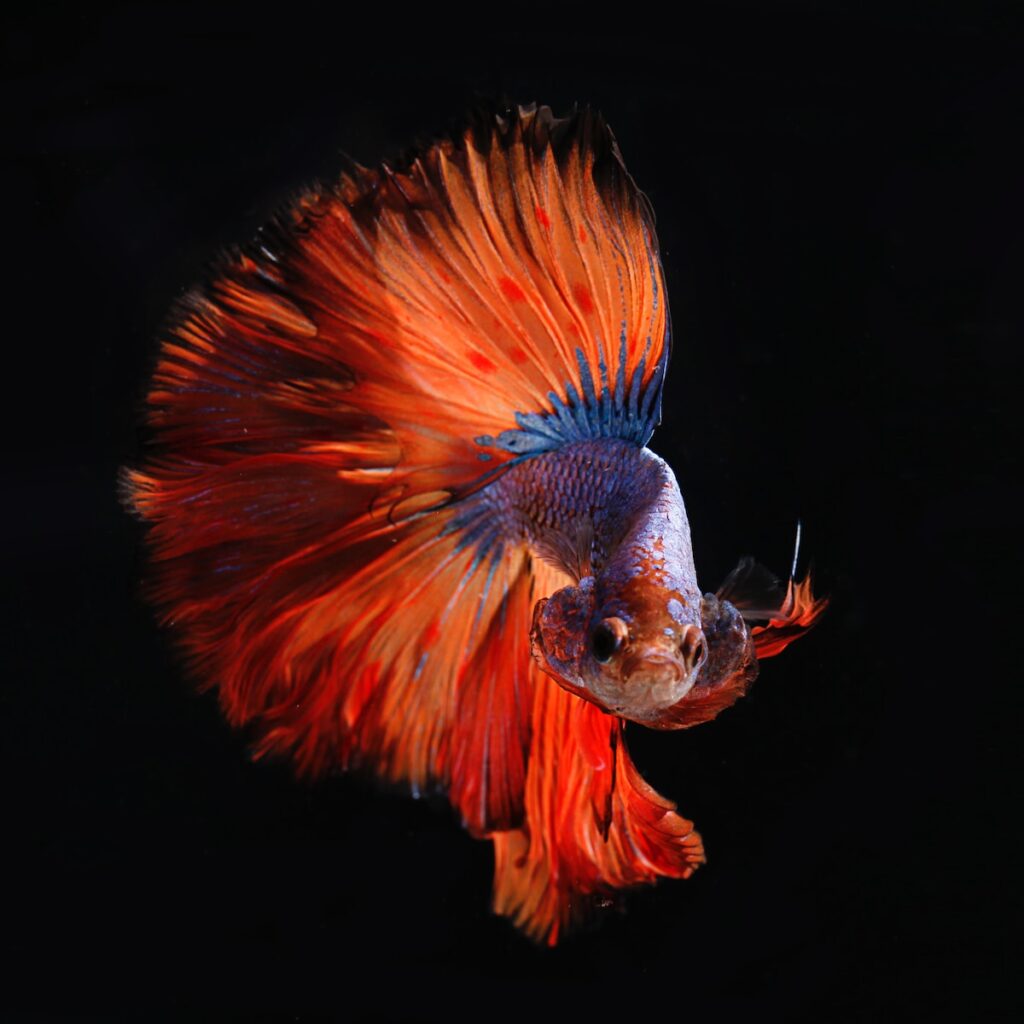

What are the Best Tank Conditions for Each Type of Betta?
Each type of betta fish has its own unique habitat and care requirements. For example, veil tail bettas prefer a tank with a lot of plants and hiding spots, while plakat bettas prefer a more open tank with plenty of room to swim.
In general, it is recommended to keep betta fish in a tank with a capacity of at least 2.5 gallons of water. Water temperature should be kept between 76-80°F and pH levels between 6.5-7.5. Bettas prefer a tank with a moderate current and plenty of hiding spots.
It’s also important to note that bettas are also known to be sensitive to water parameters, so it’s important to perform regular water changes and use a water conditioner to remove chlorine and chloramines from tap water. Additionally, it’s important to use a high-quality filtration system to keep the water free of harmful bacteria and parasites.
Different types of bettas have different temperature and water parameter requirements. For example, Plakat bettas prefer slightly warmer water and a pH level of 7.0-7.5 while Halfmoon bettas prefer a cooler water temperature of 76-78°F and a pH level of 6.5-7.0. It is important to research the specific requirements of the betta fish you are interested in before setting up the tank.
How to Decide Which Type of Betta Fish to Get?
Choosing the right type of betta fish for you will depend on your personal preferences and the conditions of your tank. If you prefer a fish with vibrant colors and long fins, a veil tail betta may be the right choice for you. If you prefer a more active and aggressive fish, a plakat betta may be a better fit.
It’s also important to consider the tank conditions and requirements of the betta fish you are interested in. If you have a smaller tank, a delta tail betta may be a better fit as they are known for their hardiness and easy-going personalities.
In addition, think about the fish personality as well; if you prefer a more peaceful fish, a female betta may be a better choice for you. If you want a more active fish, a male betta may be a better fit.
When it comes to breeding, some types of bettas such as Halfmoon bettas are more difficult to breed than others such as Plakat bettas. Be sure to research the breeding difficulty of the betta fish you are interested in before making your decision.
Conclusion
In conclusion, there are many different types of betta fish to choose from, each with its own unique characteristics and care requirements. By understanding the different types of betta fish and their specific needs, you can make an informed decision and choose the right one for you. Remember to research the specific requirements of the betta fish you are interested in and consider the conditions of your tank before making your decision. With proper care and attention, you can ensure that your betta fish will live a long and healthy life.
FAQs
How long do betta fish live?
The average lifespan of a betta fish is 3-5 years with proper care.
What kind of tank should I use for my betta fish?
A 2.5-gallon tank or larger is appropriate for betta fish. It should be equipped with a heater and filter to maintain temperature and water quality.
How often should I change the water in my betta fish tank?
It’s recommended to change at least 25-50% of the water in the tank every week, and to do a full water change of 100% every 2-4 weeks.
What kind of food should I feed my betta fish?
Bettas are carnivorous and prefer a diet of live or frozen food such as brine shrimp, bloodworms, and daphnia. They can also be fed with high-quality pellets or flakes.
How often should I feed my betta fish?
Bettas should be fed once or twice a day with small amounts of food.
What water temperature is best for betta fish?
The ideal water temperature for betta fish is between 76-80°F.
How do I know if my betta fish is healthy?
Healthy betta fish will have bright and vibrant colors, clear eyes, and fins that are not clamped or torn. They should also have a good appetite and be active.
What should I do if my betta fish stops eating?
If your betta fish stops eating, it may be due to illness or stress. Check the water quality and temperature and make sure the tank is clean. You can also try offering a variety of foods to see if that helps.
What should I do if my betta fish is not swimming?
If your betta fish is not swimming, it may be due to illness, stress, or poor water quality. Check the water temperature and quality and make sure the tank is clean.
Can betta fish live in a bowl?
While bettas can survive in small bowls, they thrive best in a 2.5-gallon tank or larger, with a heater and filter to maintain temperature and water quality.
Can betta fish live with other fish?
Bettas are territorial and aggressive fish, it’s best to keep them alone in a tank.
Can betta fish live with other fish?
Bettas are territorial and aggressive fish, it’s best to keep them alone in a tank.
Can betta fish live with snails or shrimp?
Bettas can live with snails and shrimp, but it’s important to keep an eye on the betta’s behavior towards them. Bettas may see them as food, so it’s best to ensure that the tank is large enough to provide enough hiding spots for the snails and shrimp.
How do I breed betta fish?
Breeding betta fish requires a separate tank for the breeding pair, with a pH level between 7-7.5 and a temperature of 78-82°F. The male will build a nest of bubbles and the female will lay her eggs in it. The fry should be removed from the breeding tank and placed in a separate tank for rearing.
Can betta fish change color?
Bettas can change color due to a variety of factors such as stress, water conditions, and diet.
What are the different types of betta fish?
There are a variety of different types of betta fish, including Veil Tail, Halfmoon, Crown Tail, Delta Tail, Plakat, Double Tail, Koi, Hellboy, Wild, Blue Fighter, Full Moon, White, Mustard Gas, Red Galaxy Koi, Black Samurai and Dragon Scale.
Are betta fish easy to take care of?
Bettas are relatively hardy fish and easy to care for, but they are sensitive to poor water conditions and require regular water changes and a high-quality water conditioner.
Can betta fish suffer from swim bladder disease?
Bettas can suffer from swim bladder disease, which can cause difficulty swimming and buoyancy issues. It can be caused by poor water quality, overfeeding, and constipation.
Can betta fish get sick?
Bettas can get sick, just like any other fish. Common betta fish diseases include fin rot, ich, and bacterial infections.
How can I tell if my betta fish is male or female?
Male bettas have longer fins and a more colorful appearance, while female bettas have shorter fins and a more drab coloration. However, the best way to determine the gender of a betta fish is to look at the shape of their genital papilla, which is located under the fish near the anus.
Where do betta fish come from?
Betta fish (Betta splendens) is native to the shallow, slow-moving waters of rice paddies, swamps, and streams in Southeast Asia, particularly Thailand, Cambodia, Vietnam, and Laos. The species has been domesticated for hundreds of years and has been bred for its distinctive appearance, including its bright colors, flowing fins, and aggressive personality. Over time, Betta fish have become popular pets around the world due to their beauty and relatively low maintenance needs.
Do betta fish need a heater?
Yes, Betta fish need a heater in their tank. Betta fish are tropical fish and need to be kept in a warm environment with a consistent temperature. Ideal temperature range for Betta fish is between 76-82°F (24-28°C). Maintaining a stable temperature is important for their overall health and well-being. In addition, fluctuations in temperature can cause stress and weaken the fish’s immune system, making them more susceptible to disease. A heater can help to regulate the temperature in the tank, ensuring a healthy environment for the Betta fish.
How long can a betta fish go without food?
Betta fish can go without food for up to 2-3 days without any serious harm. However, it’s not recommended to frequently skip feedings as a lack of food can lead to malnutrition and weaken the fish’s immune system. Betta fish are omnivores and need a varied diet to maintain their health and vitality. It’s best to feed them small portions 2-3 times a day, and avoid overfeeding. If you need to leave your Betta fish for an extended period of time, you can consider purchasing an automatic feeder or leaving food for them in a slow-release feeding ring. It’s important to keep a close eye on the Betta fish’s behavior and appearance to ensure they are receiving the proper care and nutrition.
Can betta fish live with other fish?
Betta fish can live with other fish, but it’s important to choose the right tank mates. Betta fish are known for their aggressive behavior and territorial nature, which can make them incompatible with certain fish species. Some fish may nip at the Betta’s fins, or they may become aggressive towards each other, leading to stress or even death.
Suitable tank mates for Betta fish include peaceful species that are of similar size, such as tetras, rasboras, and certain species of snails. It’s also important to consider the water parameters of the tank, such as temperature, pH, and water hardness, as these should be consistent for all the fish species in the tank.
It’s best to research the compatibility of each species before adding them to the tank and to provide adequate hiding places and territory for each fish. A larger tank will also help to reduce aggression and provide sufficient space for each fish to establish its own territory.
What fish can live with bettas?
Betta fish can live with other fish, but it’s important to choose the right tank mates. Some suitable options include:
- Neon tetras
- Ember tetras
- Harlequin rasboras
- Platies
- Guppies
- Otocinclus catfish
- Shrimp, such as cherry shrimp or ghost shrimp
- Snails, such as mystery snails or nerite snails
It’s important to note that not all Betta fish will tolerate other species, and some may become aggressive towards tank mates. It’s important to research each species’ behavior and requirements before adding them to the tank. A larger tank will also help to reduce aggression and provide sufficient space for each fish to establish its own territory. Additionally, it’s best to introduce new fish slowly and monitor their behavior to ensure that they are getting along.
Please also check out this article, you will find it interesting to read.Everything You Need to Know About Neocaridina Shrimp, the Perfect Pet for Beginner Aquarists
Additional References:
- International Betta Congress (IBC) – https://www.ibcbettas.org/
- Betta SPLASH – http://www.bettasplash.com/
- American Betta Breeders Association (ABBA) – https://www.americanbettabreeders.com/
- Betta Keepers United (BKU) – https://www.bettakeepersunited.com/
- Betta World – https://www.bettaworld.com/
Thank you.

